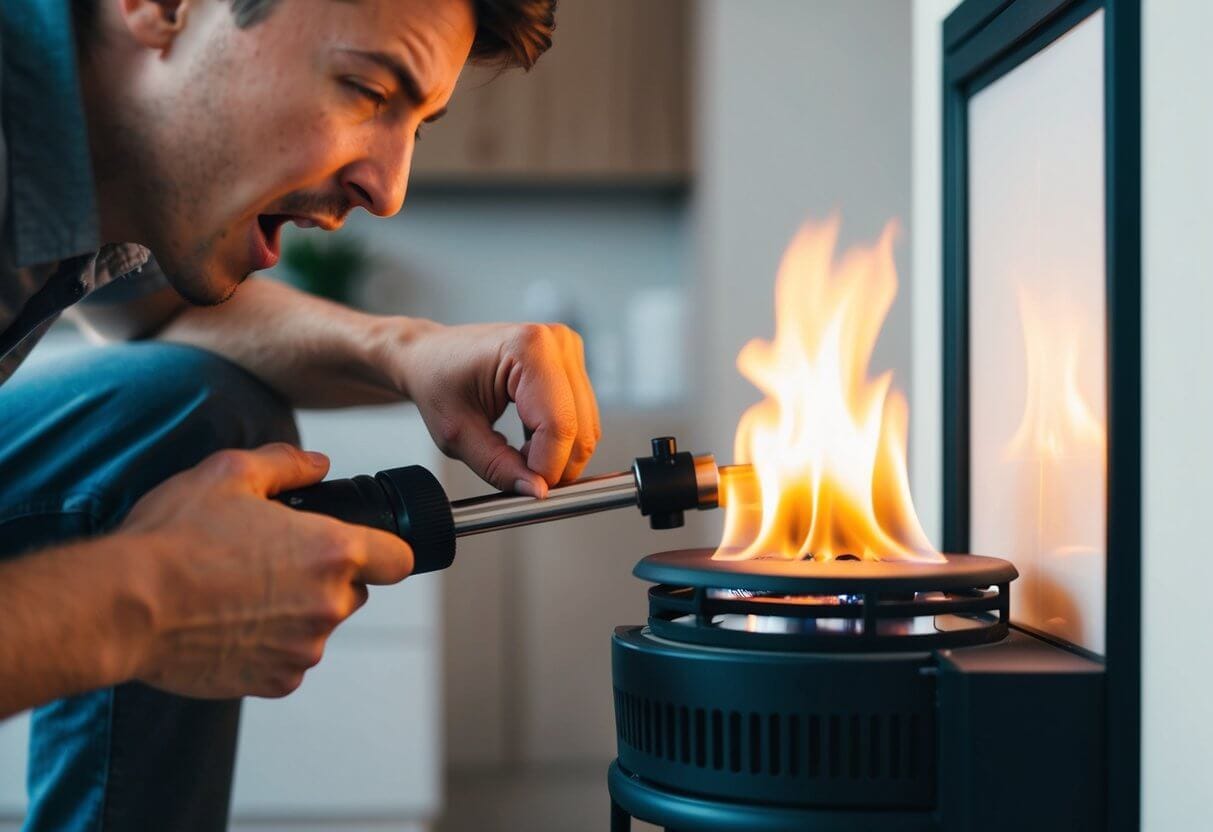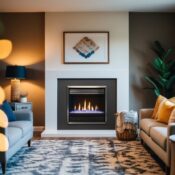
Why Gas Fireplace Won’t Light: Common Causes and Fixes
A gas fireplace can offer cozy warmth at the touch of a button, but what happens when that button doesn’t work as expected? Many homeowners experience frustration when their gas fireplace won’t light, and while there could be several reasons behind this issue, a systematic approach to troubleshooting can help identify the root cause. If your gas fireplace isn’t lighting, common culprits include the pilot light being out, gas supply issues, or a malfunctioning control valve.
In many cases, a simple fix such as ensuring the gas supply is on or reigniting the pilot light might be all it takes to get your fireplace going again. Other times, it may involve a more in-depth inspection of components like the thermocouple or gas line to ensure there are no blockages or leaks. Each of these elements plays a critical role in the seamless operation of a gas fireplace.
For those who find that basic troubleshooting doesn’t resolve the issue, it might be time to consult with a professional. Safety is paramount when dealing with gas appliances, and a qualified technician can provide expert insight and service to ensure everything is functioning correctly.
Key Takeaways
- Common issues include pilot light problems and gas supply disruptions.
- Regular maintenance can prevent many lighting issues.
- Professional service may be required for complex problems.
Understanding Your Gas Fireplace
Gas fireplaces provide warmth and ambiance by burning natural gas or propane. Understanding their basic components and ignition systems can help troubleshoot issues such as why the fireplace won’t light.
Components and Functionality
A gas fireplace typically consists of several key components that work together to produce heat and flames. The gas control valve regulates the flow of gas from the supply line to the unit. The pilot light is a small flame that ignites the main burner and is essential for operation.
Thermocouples and thermopiles are safety devices that generate electrical signals to keep the gas valve open when the pilot is lit. Without a functioning thermocouple, the pilot light won’t stay lit, preventing the fireplace from working. The flame sensor detects the presence of the flame, ensuring the system shuts down if no flame is detected.
Types of Ignition Systems
Gas fireplaces use different types of ignition systems, primarily standing pilot and electronic ignition. In a standing pilot system, the pilot light remains on continuously. This system is simple and reliable but can be less energy-efficient. On the other hand, an electronic ignition system lights the pilot only when the fireplace is in use, conserving gas.
Some electronic systems offer a battery backup for ignition during power outages. Maintenance of the ignition system, including cleaning the igniter and ensuring proper connections, is crucial to functionality. Understanding these systems aids in identifying ignition-related issues, such as why the fireplace might fail to light.
Common Issues and Diagnostic Tips
Gas fireplaces sometimes experience lighting issues due to several common anomalies. Proper inspection and troubleshooting can help resolve these issues efficiently. Below are detailed diagnostics for pilot lights, gas supply and pressure, thermocouples and thermopiles, and electrical components.
Inspecting the Pilot Light
One main reason a gas fireplace won’t light is a faulty pilot light. Start by checking if the pilot light is lit. If it isn’t, the fireplace won’t ignite. Ensure that the gas valve is fully open. When the pilot light won’t stay lit, cleaning the surrounding area may help remove any blockages or impurities.
Occasionally, air bubbles in the gas line affect pilot functionality. In this case, bleeding the line can help remove trapped air. Use a long lighter to safely test and relight the pilot light if necessary. Consistent failure may suggest a defective pilot assembly needing professional replacement.
Gas Supply and Pressure Checks
Gas supply interruptions can prevent a fireplace from lighting. Verify that the gas supply valve is open and that there are no obstructions in the line. Low gas pressure also affects performance. Assess the regulator to confirm it’s functioning and properly adjusted.
Problems like a kinked hose or gas leaks require immediate attention. Employing a leakage detector can be beneficial. If operational issues persist, contact a gas service technician to inspect the system comprehensively.
Evaluating the Thermocouple and Thermopile
The thermocouple and thermopile play critical roles in gas fireplaces. A malfunctioning thermocouple may cause the pilot light to extinguish. Hence, inspect this component for wear and corrosion. They convert heat to electric energy, which maintains the gas valve. If damaged, gas flow to the main burner is disrupted.
Testing components with a multimeter can determine electrical viability. A good reading suggests functionality, while low or zero readings indicate replacement. Thermopile requires thorough inspection since it generates voltage for the valve. Ensure wire connections are secure and undamaged.
Electrical Component Troubleshooting
Call attention to electrical elements if gas and pilot checks yield no results. Ensure the circuit breaker is not tripped, as this halts electrical flow. The wall switch, remote control, and thermostat must also be operating correctly. Testing the wall switch with a continuity tester can identify faults.
Replace batteries in remote controls and thermostats regularly. If electric spark igniters are used, assess their condition and replace them as needed. If electrical issues persist, employing a professional to examine internal wiring and components is advised for safety.
Maintenance for Optimal Performance
Regular maintenance of a gas fireplace ensures safety and efficiency. Key practices include cleaning components and scheduling inspections to prevent soot buildup and address potential issues like a dirty burner or blocked gas openings.
Routine Cleaning Procedures
Routine cleaning is essential to keep a gas fireplace operating efficiently. Dirt and soot can accumulate in the burner and other components, leading to poor performance. To maintain a clear flow of gas, owners should regularly clean gas openings and remove any carbon residue. Using a soft brush, gently clean around the burner and pilot light area to prevent blockages. Inspecting and cleaning the glass doors are also important, as soot can obscure visibility and cause staining. Tools like microfiber cloths and glass cleaners free of ammonia are recommended to avoid damage. Periodical vacuuming around the unit can help remove dust and debris, ensuring optimal airflow.
Annual Inspection Recommendations
An annual inspection by a qualified technician is crucial for comprehensive maintenance. They will assess and service the system, checking for any wear or damage to components that might need repair. Some focus areas include ensuring the pilot light and thermocouple are working properly and examining gas lines for leaks. Inspecting the fireplace’s flue and venting system is vital to confirm there are no blockages hindering air supply. Technicians also clean dirt or soot buildup in and around gas fireplace components. Regular professional inspections not only address current issues but also prevent future ones, minimizing the need for unexpected gas fireplace repairs.
Troubleshooting Flame Issues
When a gas fireplace refuses to light, a few common culprits often come into play. These include a faulty gas valve, inadequate gas pressure, and improper flame color. Each issue has its own set of symptoms and solutions.
Identifying a Faulty Gas Valve
A faulty gas valve may be the reason the fireplace won’t ignite. The gas valve controls the flow of gas to the fireplace. If the valve is stuck or malfunctioning, gas flow will be restricted. This can prevent the pilot flame from igniting.
To check if the valve is functioning, listen for a clicking noise when it’s turned on. No sound might indicate a problem. Inspect the valve for dirt or damage. If necessary, consult a professional technician to replace it.
Recognizing Inadequate Gas Pressure
Inadequate gas pressure is another common issue. Proper gas pressure ensures that the flame lights and stays lit. Low pressure can result in a weak or non-existent flame. On the other hand, excessive pressure might produce an unsafe, high flame.
To measure gas pressure, use a manometer. Compare the readings with manufacturer specifications. If the pressure is off, adjust the gas control valve or contact a professional for calibration.
Adjusting for Proper Flame Color
Flame color is an important indicator of gas fireplace health. A blue flame suggests complete combustion, which is ideal. An orange flame often indicates incomplete combustion, pointing to dirt or incomplete air mixing.
Inspect the primary air shutter or burner ports for blockages. Clean debris to ensure optimal air flow. Ensure that the gas control valve is correctly set, allowing the proper mix of gas and air. If the color issues persist, professional evaluation might be required.
When to Seek Professional Service
If a gas fireplace won’t light after troubleshooting, professional help is advisable. A qualified technician can pinpoint complex issues like broken thermocouples or faulty igniters, often unnoticed by homeowners.
Regular gas fireplace maintenance can prevent long-term issues. Technicians perform necessary checks, clean carbon deposits, and ensure safe operation. Hiring professionals can help avoid expensive gas fireplace repairs down the line.
When the pilot light is on but the main burner is not, fireplace repair might be needed. Professionals can examine the entire gas line and controls to fix any underlying problems.
If there are repeated issues with lighting the fireplace or unusual odors are detected, it’s crucial to contact a fireplace service provider. This ensures safety and prevents potential hazards.
Engaging professional assistance ensures the gas fireplace operates efficiently and safely, keeping homes warm without unexpected inconveniences.
Frequently Asked Questions
Gas fireplaces may experience issues such as starting failures, malfunctioning remotes, and problems with spark but no flame. Troubleshooting often involves checking and resetting components.
What steps should be taken when the pilot light is on but the fireplace won’t ignite?
If the pilot light is lit but the fireplace does not ignite, first ensure the control valve is set to the “on” position. Check for any obstructions in the burner orifice and clean it if necessary. A faulty thermocouple or thermopile can also prevent ignition and may need replacement.
How does one troubleshoot a gas fireplace that clicks but fails to ignite?
If a clicking sound is heard but the fireplace doesn’t light, inspect the ignition system for wear or damage. Ensure electrical connections are tight and clean any corrosion. Verify that there is a steady gas flow and the spark igniter is positioned correctly near the burner.
What common issues prevent a gas fireplace from being activated with a remote?
Remote control problems may arise from battery issues or signal obstructions. Replacing the batteries in the remote and receiver might solve these problems. Also, check the receiver’s position and relocate any items that might block the signal.
What methods are used to reset a ventless gas fireplace?
To reset a ventless gas fireplace, switch off the main gas supply. Wait a few minutes before turning it back on. Relight the pilot light following manufacturer instructions. If issues persist, ensure the oxygen depletion sensor and control module are operating correctly.
Why might the flames fail to appear even though my gas fireplace is sparking?
When the fireplace sparks but no flames appear, confirm gas flow to the burner is unobstructed. This can include checking the gas shut-off valve and cleaning the burner orifices. Additionally, ensure that the spark igniter is functioning and positioned next to a gas source.
What could be the reasons behind a gas fireplace’s failure to light up?
A variety of problems could cause a gas fireplace not to light, including an extinguished pilot light, clogged burners, or low gas pressure. Broken thermocouples or thermopiles are also common issues. Regular maintenance can help prevent these problems by keeping components clean and functioning.


